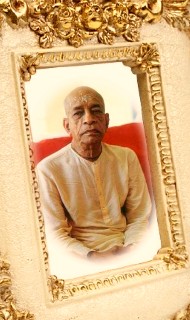
Interfaith Encounter in Dundas Square, Toronto.
Mangal Aarti Devi Dasi: A few days ago I was distributing books in Dundas Square, Toronto, when I stopped a young man from Germany who was on vacation. I showed him a copy of “Beyond Birth and Death” and said a little something to pique his interest. In the middle my talk an elderly man distributing free copies of the Koran walked over from the corner and tried to hand him some books on Islam. Here’s what ensued:
The Muslim representative encouraged the German to take his books, saying “You should research all religions.” I didn’t get angry at this intrusion but tried to sympathize with the older man, recognizing that he had a genuine desire to share his spiritual and cultural values for the benefit of others. This is purifying for any heart, I thought.
Then came the reply from the German: “No, thanks, I’m fine with this one [Prabhupada’s book].” As for me, rather than becoming proud of having won the bout of the books, I felt compassion for the Muslim and tried to minimize the feelings of rejection and dejection he must have felt. I prayed for a swift end to his negative feelings. After the German boy gave me ten euros and walked away, I turned away from the elderly man, trying not to give him the impression I was reveling in his defeat. I had a few moments to reflect on how often I’d tried to go out on a limb to present Krishna consciousness to someone, only to receive a big blow to my false ego in return.
Just then a boy named Joseph walked up to me. He introduced himself as someone who’d once visited our Toronto temple. He was eager to purchase a few books. I was curious about how fascinating the flow of interactions on book distribution can sometimes be. As he was explaining his interest, he revealed his true intention. He had come as an ambassador from the Muslim man. Joseph told me that the man had asked him to approach me to ask what we were all about. I decided the best thing would be to go over myself and present the Bhagavad-gita to the elderly gentleman personally. I wanted to make him my friend. He took a “Bhagavad-Gita As It Is” on Joseph’s donation, and I walked away with some books on Islam. It was a cultural exchange and a successful real-time interfaith dialogue.
Your Servant,
Mangal Aarti Devi Dasi











 By Bhakti Raghava Swami
By Bhakti Raghava Swami By Lakshman das
By Lakshman das By His Divine Grace A.C.B. Swami Prabhupada
By His Divine Grace A.C.B. Swami Prabhupada




















 By Chirag Dangarwala
By Chirag Dangarwala By Giriraja Swami
By Giriraja Swami